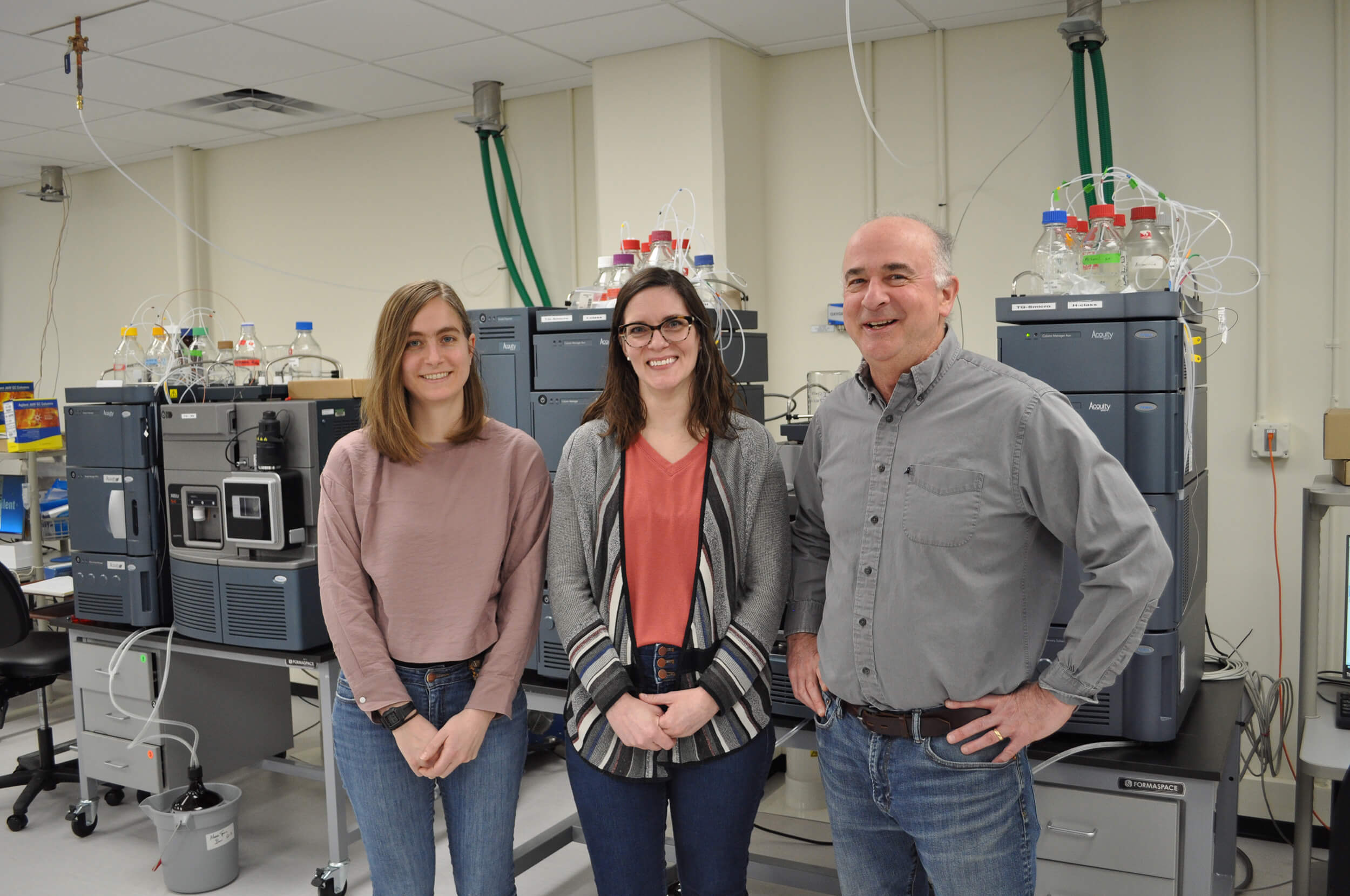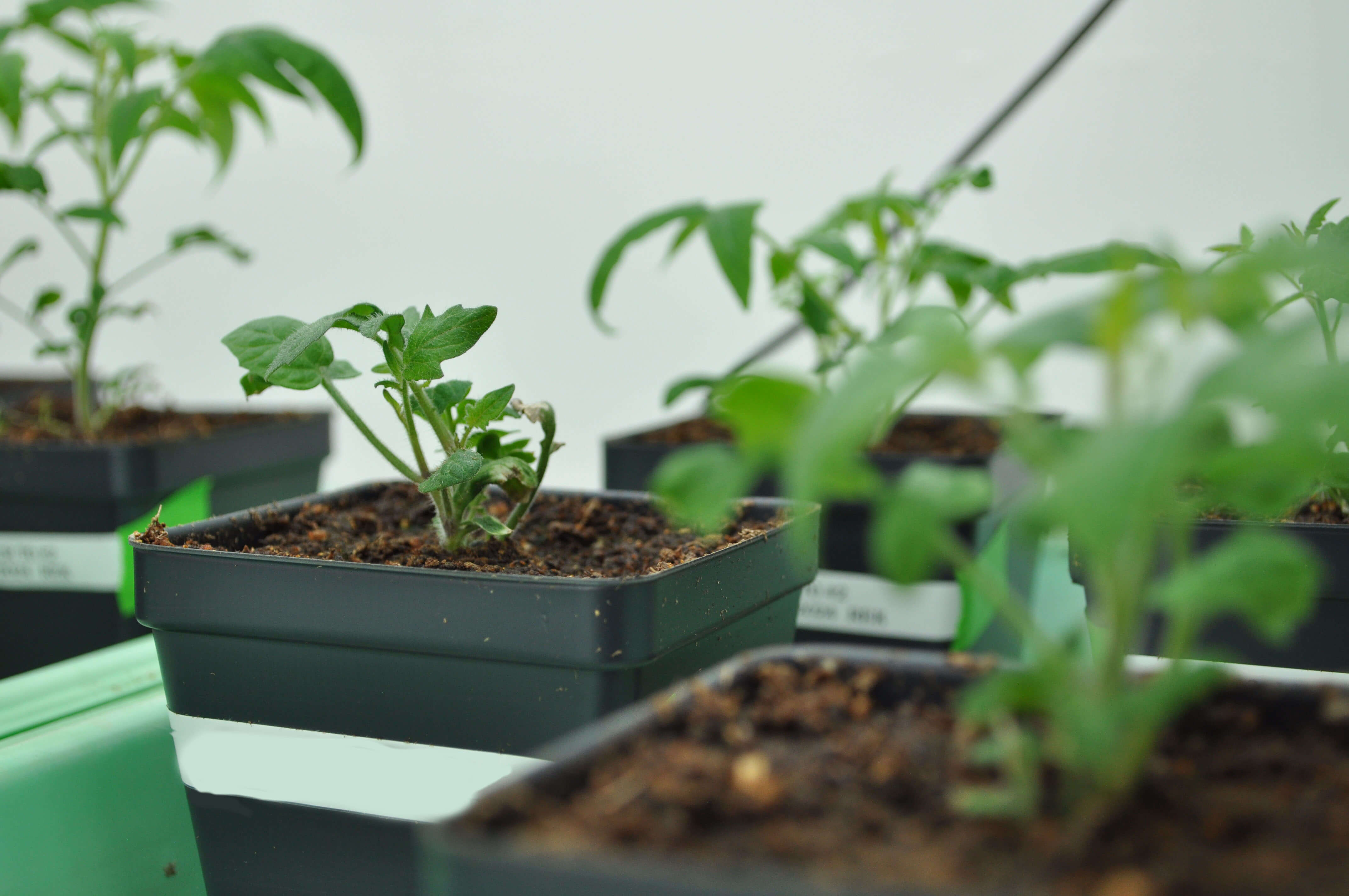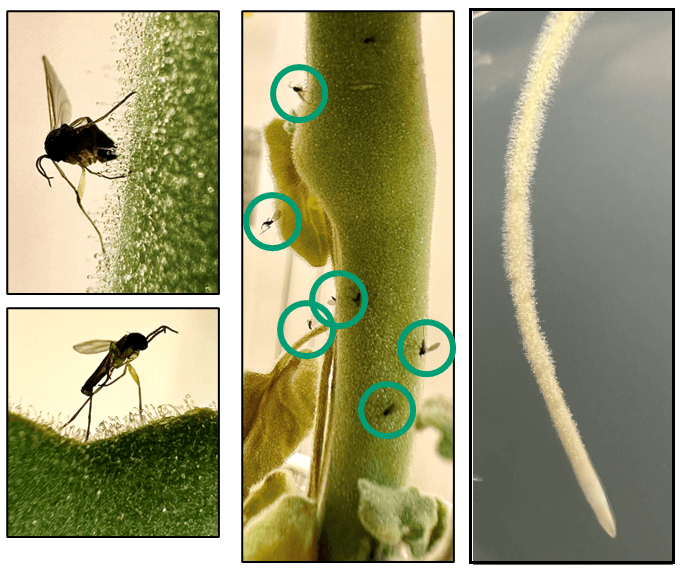Uncovering a 'parallel universe' in tomato genetics
Article Highlights
- Researchers at Michigan State University haveunraveled a surprising genetic mystery centered on acylsugars in tomato plants. These are sticky defense metabolites usually found in tiny hairs on a plant’s surface.
- Led by Professor Robert Last and postdoctoral researchers Rachel Kerwin and Jaynee Hart, the team reported the discovery of a genetic “parallel universe” in which acylsugars are also found in tomato roots.
- These findings shed new light on the evolutionary story of the Solanaceae plant family and the ways defense metabolites like acylsugars could lead to improved natural pesticides.
In a new paper appearing in Science Advances, Michigan State University researchers have unraveled a surprising genetic mystery centered on sugars found in what gardeners know as “tomato tar.”
Anyone who has pruned tomato plants barehanded has likely found their fingers darkened with a sticky, gold-black substance that won’t quite wash off.
This tomato tar is sticky for good reason. It’s made of sugars — acylsugars, to be precise — and acts as a sort of natural flypaper for would-be pests.
“Plants have evolved to make so many amazing poisons and other biologically active compounds,” said Michigan State researcher Robert Last, leader of the new study.
The Last lab specializes in acylsugars and the tiny, hair-like structures where they’re produced and stored, known as trichomes.

Once thought to be exclusively found in trichomes, acylsugars were recently discovered in tomato roots as well by other researchers. This was a surprise for the plant science community.
In its study, the team at MSU wanted to learn how these root acylsugars functioned and just where they came from.
They found that not only do tomato plants synthesize chemically unique acylsugars in their roots and trichomes, but these acylsugars are produced through two parallel metabolic pathways.
This is the equivalent of assembly lines in an auto factory making two different models of the same car, but never interacting.
These discoveries are helping scientists to better understand the resilience and evolutionary story of Solanaceae, or nightshades, a sprawling family of plants that includes tomatoes, eggplants, potatoes, peppers, tobacco and petunias. The findings could also help inform researchers looking to develop molecules made by plants into compounds to help humanity.
“From pharmaceuticals, to pesticides, to sunscreens, many small molecules that humans have adapted for different uses come from the arms race between plants, microbes and insects,” Last said.
Roots and shoots
Beyond key chemicals essential for growth, plants also produce a treasure trove of compounds that play a crucial role in environmental interactions. These can attract useful pollinators and are the first line of defense against harmful organisms.
“What’s so remarkable about these specialized metabolites is that they’re typically synthesized in highly precise cells and tissues,” said Rachel Kerwin, a postdoctoral researcher at MSU and first author of the latest paper.

“Take for instance acylsugars. You won’t find them produced in the leaves or stems of a tomato plant. These physically sticky defense metabolites are made right in the tip of the trichomes.”
When it was reported that acylsugars could be found in tomato roots as well, Kerwin took it as a call for old-fashioned genetic detective work.
“The presence of these acylsugars in roots was fascinating and led to so many questions. How did this happen, how are they being made and are they different from the trichome acylsugars we’ve been studying?”
To begin tackling the evolutionary enigma, lab members collaborated with specialists at MSU’s Mass Spectrometry and Metabolomics Core, as well as staff at the Max T. Rogers Nuclear Magnetic Resonance facility.
In comparing metabolites from tomato seedlings’ roots and shoots, a variety of differences appeared.
The basic chemical make-up of the aboveground and belowground acylsugars were noticeably different, so much so that they could be defined as different classes of acylsugars entirely.
Breaking the car
Last, a University Distinguished Professor in MSU’s College of Natural Science's Department of Biochemistry and Molecular Biology and Department of Plant Biology, offers a useful analogy to explain how a geneticist approaches biology.
“Imagine trying to figure out how a car works by breaking one component at a time,” he said. “If you flatten a car’s tires and notice the engine still runs, you’ve discovered a critical fact even if you don’t know what the tires exactly do.”
Switch out car parts for genes, and you get a clearer picture of the work accomplished by the Last lab to further crack the code on root acylsugars.

Looking at public genetic sequence data, Kerwin noticed that many of the genes expressed in tomato trichome acylsugar production had close relatives in roots. After identifying an enzyme believed to be the first step in root acylsugar biosynthesis, the researchers began “breaking the car.”
When they knocked out the root acylsugar candidate gene, root acylsugar production vanished, leaving trichome acylsugar production untouched.
Meanwhile, when the well-studied trichome acylsugar gene was knocked out, root acylsugar production carried on as usual.
These findings offered striking proof of a suspected metabolic mirroring.
“Alongside the aboveground acylsugar pathway we’ve been studying for years, here we find this second parallel universe that exists underground,” Last said.
“This confirmed we have two pathways co-existing in the same plant,” Kerwin added.
To drive home this breakthrough, Jaynee Hart, a postdoctoral researcher and second author on the latest paper, looked closer at the functions of trichome and root enzymes.
Just as trichome enzymes and the acylsugars they produce are a well-studied chemical match, she found a promising link between root enzymes and the root acylsugars as well.
“Studying isolated enzymes is a powerful tool for ascertaining their activity and drawing conclusions about their functional role inside the plant cell,” Hart explained.
These findings were further proof of the parallel metabolic pathways that exist in a single tomato plant.
“Plants and cars are so different, yet similar in that when you open the proverbial hood you become aware of the multitude of parts and connections that make them function. This work gives us new knowledge about one of those parts in tomato plants and prompts further research into its evolution and function and whether we can make use of it in other ways,” said Pankaj Jaiswal, a program director at the U.S. National Science Foundation, which funded the work.
“The more we learn about living things — from tomatoes and other crops, to animals and microbes — the broader the opportunities to employ that learning to benefit society,” he added.
Clusters within clusters
The paper also reports a fascinating and unexpected twist concerned with biosynthetic gene clusters, or BGCs.
BGCs are collections of genes that are physically grouped on the chromosome and contribute to a particular metabolic pathway.
Previously, the Last lab identified a BGC containing genes linked to trichome acylsugars in tomato plants. Kerwin, Hart, and their collaborators have now discovered the root-expressed acylsugar enzyme resides in the same cluster.
“Usually in BGCs, the genes are co-expressed in the same tissues and under similar conditions,” said Kerwin.
“But here, we have two separate yet interlinked groups of genes. Some expressed in trichomes, and some expressed in roots.”
This revelation led Kerwin to dive into the evolutionary trajectory of Solanaceae species, with hopes to identify when and how these two unique acylsugar pathways developed.
Specifically, the researchers drew attention to a moment some 19 million years ago when the enzyme responsible for trichome acylsugars was duplicated. This enzyme would one day be responsible for the newly discovered root-expressed acylsugar pathway.
The exact mechanism that “switched on” this enzyme in roots remains unknown, paving the way for the Last lab to continue to unpack the evolutionary and metabolic secrets of the nightshade family.
“Working with Solanaceae provides so many scientific resources, as well as a strong community of researchers,” said Kerwin.
“Through their importance as crops and in horticulture, these are plants humans have cared about for thousands of years.”
For Last, these breakthroughs are also a reminder of the importance of natural pesticides, which defense metabolites such as acylsugars ultimately represent.
“If we find that these root acylsugars are effective at repelling harmful organisms, could they be bred into other nightshades, thereby helping plants grow without the need for harmful synthetic fungicides and pesticides?” Last asked.
“These are questions at the core of humanity’s pursuit of purer water, safer food and a reduced reliance on harmful synthetic chemicals.”